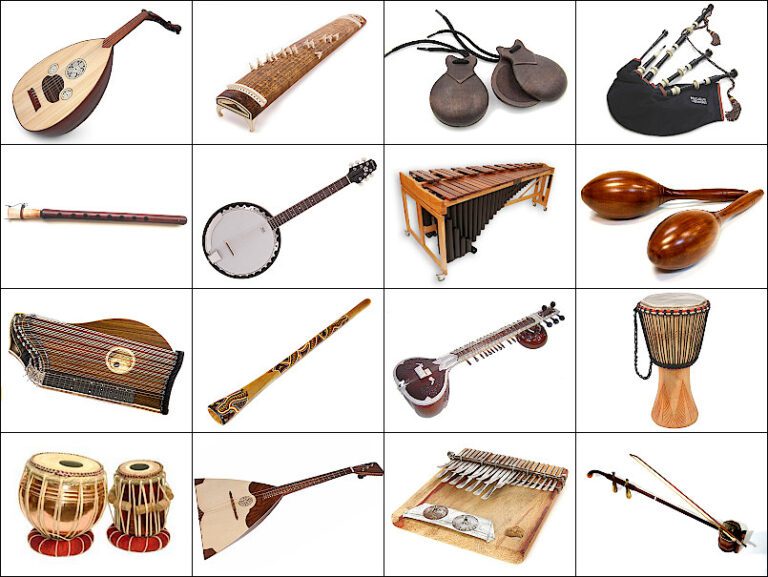Musical Instrument Names in Shanghainese
Welcome to our blog post on musical instrument names in Shanghainese! Shanghainese is a dialect of Chinese spoken in Shanghai, China, and it has its own unique names for various musical instruments. In this post, we will explore some of the common musical instrument names in Shanghainese and learn more about the rich musical culture of this region. So, grab your instrument and let’s dive in!
Musical Instrument Names in Shanghainese
1. 笛 diah – a wind instrument similar to a flute
2. 琴 cin – a string instrument similar to a guitar
3. 鼓 gu – a percussion instrument like a drum
4. 箫 sio – a small wind instrument like a flute
5. 萨克斯风 saxophone feng – a brass instrument with a reed mouthpiece
6. 小提琴 violin cin – a string instrument played with a bow
7. 喇叭 trumpet – a brass instrument with a flared bell
8. 萨克斯管 saxophone – a woodwind instrument with a curved shape
9. 豎琴 harp – a string instrument played by plucking strings
10. 古箏 guzheng – a traditional Chinese zither with movable bridges
11. 爵士鼓 drum – a set of drums typically used in jazz music
12. 电吉他 electric guitar – a guitar with pickups that amplify sound
13. 键盘 keyboard – an electronic instrument with keys for playing notes
14. 長號 trombone – a brass instrument with a slide to change pitch
15. 笛子 flute – a wind instrument with a high-pitched sound
16. 铁琴 xylophone – a percussion instrument with wooden bars
17. 大提琴 cello – a string instrument played between the legs
18. 司机 accordion – a portable wind instrument with keys and buttons
19. 架子鼓 drum set – a collection of drums and cymbals
20. 吉他 guitar – a string instrument played by strumming or plucking
21. 大鼓 bass drum – a large percussion instrument with a deep sound
22. 手风琴 harmonica – a small wind instrument played by blowing air through reeds
23. 钢琴 piano – a keyboard instrument with hammers that strike strings
24. 长笛 piccolo – a small flute that plays high notes
25. 奏鳴曲 sonata – a musical composition for solo instrument or small ensemble
26. 编钟 chimes – a percussion instrument with hanging tubes or bars
27. 萨瓦鲁 darbuka – a goblet-shaped drum used in Middle Eastern music
28. 電子風琴 organ – a keyboard instrument that produces sounds electronically
29. 薩克斯風 saxophone – a woodwind instrument with a brass body
30. 鈴鐺 sleigh bells – a set of bells attached to a handle for shaking
31. 長號 trumpet – a brass instrument with a cup-shaped mouthpiece
32. 吹響哨 whistle – a wind instrument that produces a loud sound
33. 跳板 cymbal – a metal percussion instrument that clangs when struck
34. 喇叭管 clarinet – a woodwind instrument with a single-reed mouthpiece
35. 貝斯小提琴 bass violin – a large string instrument played like a cello
36. 單簧管 oboe – a woodwind instrument with a double-reed mouthpiece
37. 簫管 piccolo – a small woodwind instrument that plays high notes
38. 雙簧管 bassoon – a woodwind instrument with a conical shape
39. 喇叭鈴 sleigh bells – a set of bells attached to a handle for shaking
40. 硬板 xylophone – a percussion instrument with wooden bars
41. 鍵盤 keyboard – an electronic instrument with keys for playing notes
42. 開放式鼓 set – a collection of drums and cymbals
43. 長笛 piccolo – a small flute that plays high notes
44. 流行樂 guitar – a string instrument played by strumming or plucking
45. 手指鼓 drum set – a large percussion instrument with a deep sound
46. 鈴琴 chimes – a percussion instrument with hanging tubes or bars
47. 開放式風琴 organ – a keyboard instrument that produces sounds electronically
48. 合唱團 saxophone – a woodwind instrument with a brass body
49. 鐵嘴琴 harmonica – a wind instrument played by blowing air through reeds
50. 爆米花 guitar – a string instrument played by strumming or plucking
Conclusion
In conclusion, the unique musical instrument names in Shanghainese reflect the rich cultural heritage and linguistic diversity of Shanghai. These names offer a glimpse into the local dialect and provide insight into the history and significance of music in the region. By exploring the origins and meanings of these names, we can gain a deeper appreciation for the instruments themselves and the musicians who play them. As we continue to preserve and celebrate traditional music and language, we can ensure that these important cultural elements will be passed down to future generations. Let us continue to embrace and cherish the musical traditions of Shanghai and beyond.

